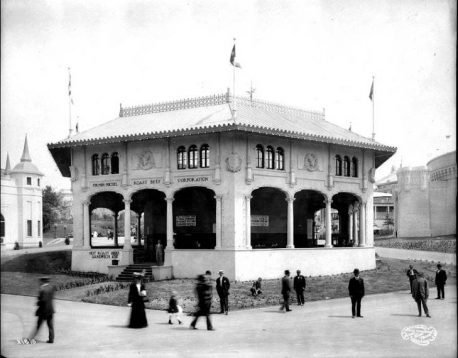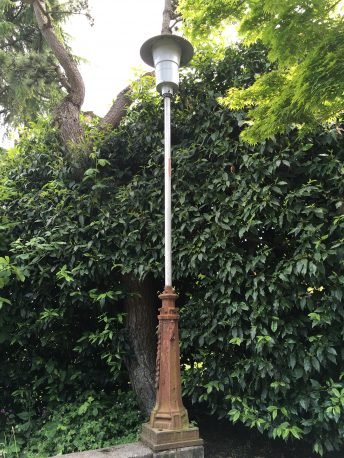The Reappearing Disappearing Lampposts of Willcox Walls
This story started out as a little snippet about the lampposts on the Willcox Walls along 7th and 8th Avenues W. Now it’s turned into an article exploring 1) the history of these beautiful bits of street furniture; 2) their marvelous reconstruction; 3) their curious new sites in street ends, front yards and back; 4) the countless varieties of restoration; 5) the best preserved examples and 6) recently discovered examples.
In 1906, the Queen Anne Club, a group of influential residents (the record only mentions men), lobbied the city’s Parks Board to build Queen Anne Boulevard. Queen Anne had been left out of the Olmsted Brother’s boulevard plan. These rich and powerful folks angrily demanded inclusion in the plan. Eventually, they got their way.
The city’s plan for Queen Anne Boulevard included the West Queen Anne Retaining Walls designed by W.R.B. Willcox and constructed in 1914. The walls are extremely popular. As a result, in 1975/76 they were among the very first designated city landmarks. It helped that Earl Layman, the person who prepared their nomination, was the City Conservator and a Queen Anne resident who lived just down the hill. As a young man, he had studied with Willcox at the University of Oregon.
A photograph taken in 1982 shortly after their designation as a city landmark shows how much the lampposts had deteriorated and how much the city had altered their historic appearance. It proves that one lamppost I thought poorly restored had been in fact severely altered by the city before its removal. Here we see offensive brackets holding the globe and those protruding cables. Notice how the decorative laurel leaves have fallen away from the post's eastern and southern sides. The west facing one appears to be more intact.
The walls popularity led to their partial restoration as part of project funded by the 1989 parks levy. At that time the Parks Department decided not not to repair the original lampposts, but to replace them with new ones. The laurel leaf decorations down the legs of the lampposts apparently rusted off most of the posts before their removal from the wall. The missing metal parts were probably factors in the decision to replace all the fixtures. Apparently, a cast was made of the best-preserved lamppost to serve as the form for all the new ones.[i] Aside from an electrical cover, the replacement lampposts appear to be cast in one piece.
Legal constraints probably prohibited the city from selling the lampposts, so it gave all or some of the original lampposts to the Queen Anne Community Council which in its turn sold them to interested neighbors. There doesn’t seem to be record of how many were sold. If you look hard you may find some of the 65 [ii] historic lampposts scattered around the neighborhood.
In a couple of recent ambles about Queen Anne inspired by Covid-19 confinement, I’ve found four pairs of these lampposts and three singletons. Two of the pairs and two of the singletons were unknown to me before I started to hunt them down.
One restored lamppost sits on 2nd Ave. W. near Crockett. Bruce Jones, a former member of the board of the Queen Anne Historical Society, acquired it from his neighbor in 2016 and set it up in his front yard. Jones removed the egregious bracket and cables the city had installed. He had no way of recreating the laurel leaf decorations running down the lamppost sides.
There is another lone lamppost at 1616 4th Ave. W. next to the former Masonic Center and across from the library. It has been painted but not restored. I like it because the laurel leaves down the (now) northern side are rusting and pulling away from the post providing evidence of how all the lampposts deteriorated. They simply rusted apart over time and fell from their mountings.
I guess the laurel leaves are Neo-Classical reminders of the crown worn by Roman emperors. In 1914 when the walls were built, the Beaux Arts Movement popular in the United States from about 1880 to 1930 and favoring classical styles was all the rage. Willcox’s roast beef pavilion at the 1909 Alaska-Yukon-Pacific Exposition displayed whimsical classical columns.
The last one I found has moved to that curious part of Queen Anne Boulevard that wraps to the north from W. Wheeler St. along 10th W. It retains the anachronistic brackets holding the globe. It ties this often neglected part of the landmark boulevard and its simple homes to its more famous sections along the Willcox Walls and Highland Drive.
I discovered my first pair of lampposts in a garden on 7th W. where W. Comstock plunges down the hill. Its globes are a disquieting choice, but they underscore the difficulty in finding replacements for the ones W. R. B. Willcox chose. I am glad to see the lamposts saved, in pretty good shape and at the ready for restoration. Like the ones on 2nd W. and 4th W., this pair is missing the decorative laurel leaves.
This is one of a pair found in a backyard on 7th Ave. W. A friend lives next door and alerted me to their survival. Like many of the survivors, it looks out of place in its new location. Here, one of them pretends to be a flower in the middle of a carefully planted garden.
Lamppost hidden in a back yard on 7th W.
Two of the weirdest pairs I found at dead ends overlooking Aurora Avenue[iii]. The pair at the end of McGraw are in terrible shape and got horribly bastardized with modern lamps on poles stuck through them. (Only one of them retains the modern adaptation).
Both this pair and the one at the end of Boston Street in the laurel hedge strike me as illegal installations. It looks like some private folks acquired the lampposts when the city took them down and propped them up on public walls. I may be too quick on the draw here, for snooping in the laurel bushes that hide the Boston St. pair, I discovered official City Light stickers on them. City Light hasn’t gotten back to my inquiry about the stickers. This pair are in super condition, as if the laurel bushes know they are protecting one of their own.
Amazingly, these incredible lampposts keep on popping up. In late April 2020, Sally G., wrote from Marysville with news of one of our historic lampposts. Sally reported she “grew up in QA Hill (9th & Wheeler), and my dad bought one of the lampposts that had been on Highland Drive (sic) a couple decades ago. I’m now the proud owner of this beautiful piece of history, and my husband and I are restoring it to its glory. We grew up at 2509 9th Ave. W., and Yantis is my maiden name. My dad was a Seattle firefighter and was in the very first class of the Medic One EMT training program. His main station was Station 8, near Queen Anne High School. In fact, during my sophomore year, he would drop me there on his way to work. It would be super early, so I would sit on the 4th floor stairs, watching the sun rise. He retired as a Lieutenant after 25 years, and then went to work at the UW in their fire marshal’s office for another 25. My mom’s name was Ruth Yantis, and my dad’s name was Stanley Yantis Sr."
The Marysville lamppost has the same wires entering the globe and the same bracket as the one on 4th W. across from the library and those in the 1982 photograph. The bracket holds the plastic globe with a screw. Only the Marysville example had a distinctive happy face made of black electrical tape.
Like almost all the historic lampposts, the Marysville example arrived at Sally’s missing the decorative laurel leaves. She was lucky because either her father or her sister who had stored the lamppost for decades, had snagged a perfectly good set of four that the restoration plan calls for reattaching. Sally shared a photo of the decorative parts on her dining room table.
Sally updated the story about her lamppost on June 11, 2020 sharing a photograph of it following the meticulous restoration by Sally and her husband Tim Grube. The color is strikingly different from the modern posts on the walls. Longtime Queen Anne residents believe light green is a pretty good choice.
Without looking in every back yard and not counting Marysville, I’ve found 11 lampposts. Maybe like Stanley Yantis, you have one buried under some egregious tangle of ivy. Maybe you have one awaiting restoration in your basement and didn’t know what it was or where it was from. The Marysville story gives hope that someday all 65 lampposts will see the light of day. If you find one, let us know at info@qahistory.org. We'll add your story here.
March 18, 2021: Zipping down the hill on Warren Avenue North, two more lampposts popped up just this week. They are missing the laurel leaves and have acceptable replacement globes. We've now found 14 of the original lampposts. Keep lookin'!
[I] More research needs to be one on this.
[ii] Relying on empirical science can be risky. I found mention in historic documents of over 60 lampposts, but walking along the walls counting the modern ones I found only 50. Reviewing a historic photograph, I discovered 15 lampposts below the wall where there are stairs, six at W. Garfield, six just south of W. Lee and three on the steps just north of Betty Bowen Viewpoint. I found the last three at press time. They make a grand total of 65.
[iii] I confess that Leanne Olson, a member of the QAHS board, shared the Boston pair and with me.














